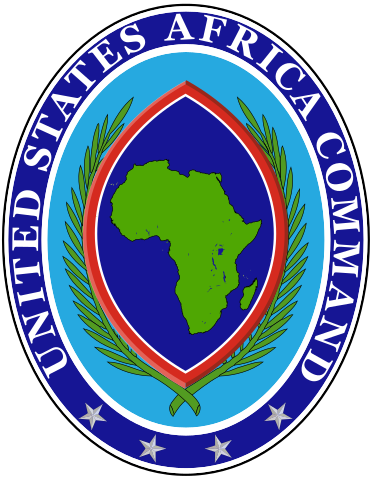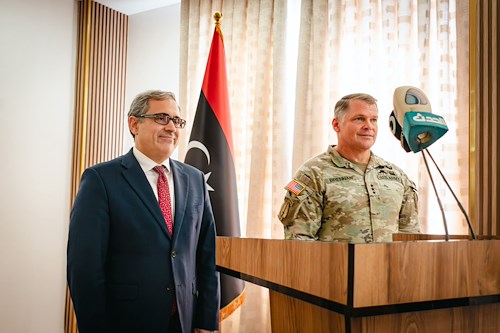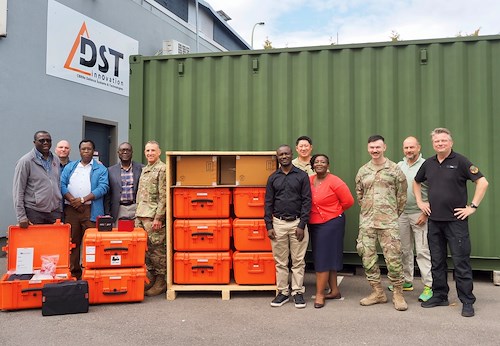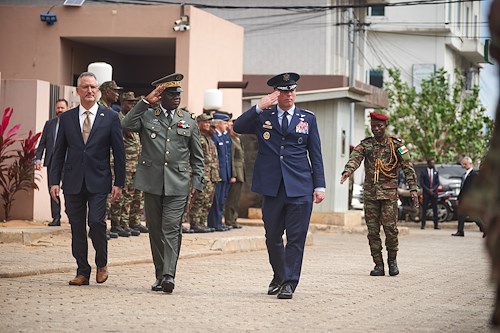Gallery contains 14 images
×
Photo 1 of 14
New mobile hospital enhances Ugandan military capacity
Members of the Uganda People’s Defence Force, Uniformed Services University of the Health Sciences, and vendor trainers pose for a group photo in front of a UN-standard level-2 hospital, at the Uganda Rapid Deployment Capabilities Center in Jinja, Uganda, May 15, 2019. Members of UPDF conducted training on efficiently and effectively setting-up, taking down and operating a UN-standard level-2 hospital, at the Uganda Rapid Deployment Capabilities Center in Jinja, Uganda, May 6-17, 2019, as a part of the African Peacekeeping Rapid Response Partnership program.
Photo by: U.S. Army Staff Sgt. Grady Jones
Photo 2 of 14
New mobile hospital enhances Ugandan military capacity
JINJA, Uganda--1st Lt. Vincent Nzayisenga, medical clinic officer, Uganda People’s Defence Force, gives directives to UPDF soldiers about the layout of a UN-standard level-2 mobile treatment facility, May 15, 2019, during the vendor training event at the URDCC motor pool, Jinja, Uganda.
(Photo by U.S. Army Staff Sgt. Grady Jones, Public Affairs, U.S. AFRICOM)
Photo by: U.S. Army Staff Sgt. Grady Jones
Photo 3 of 14
New mobile hospital enhances Ugandan military capacity
JINJA, Uganda--Cpt. Timothy Muyimbo, anesthesiologist, Uganda People’s Defence Force, gives a brief of the operation of a UN-standard level-2 mobile treatment facility to Maj. Gen. Ambrose Musinguzi, chief of medical services, UPDF, and Maj. Gen. Paul Lokech, commandant, Uganda Rapid Deployment Capabilities Center, UPDF, May 15, 2019, during a visit to the vendor training event in the URDCC motor pool, Jinja, Uganda.
(Photo by U.S. Army Staff Sgt. Grady Jones, Public Affairs, U.S. AFRICOM)
Photo by: U.S. Army Staff Sgt. Grady Jones
Photo 4 of 14
New mobile hospital enhances Ugandan military capacity
JINJA, Uganda--Soldiers from Uganda People’s Defence Force listen to guidance from vendor trainers, May 13, 2019, as they trained to assemble and operate UN-standard level-2 mobile treatment facility, at the Uganda Rapid Deployment Capabilities Center in Jinja, Uganda, May 13, 2019, as a part of vendor training under the African Peacekeeping Rapid Response Partnership program.
(Photo by U.S. Army Staff Sgt. Grady Jones, Public Affairs, U.S. AFRICOM)
Photo by: U.S. Army Staff Sgt. Grady Jones
Photo 5 of 14
New mobile hospital enhances Ugandan military capacity
A UN-standard level-2 mobile treatment facility stands in the motor pool of the Uganda Rapid Deployment Capabilities Center in Jinja, Uganda, May 16, 2019. Soldiers from Uganda People’s Defence Force (UPDF) recently conducted training on efficiently and effectively setting-up, taking down and operating the mobile hospital at the Uganda Rapid Deployment Capabilities Center in Jinja, Uganda, May 6-17, 2019, as a part of vendor training under the African Peacekeeping Rapid Response Partnership program.
(Photo by U.S. Army Staff Sgt. Grady Jones, Public Affairs, U.S. AFRICOM)
Photo by: U.S. Army Staff Sgt. Grady Jones
Photo 6 of 14
New mobile hospital enhances Ugandan military capacity
JINJA, Uganda--Lt. Col. Sueann Ramsey, director, Program and Joint Force Support Center for Global Health Engagement, Uniformed Services University of the Health Sciences, shakes hands with Maj. Gen. Paul Lokech, commandant, Uganda Rapid Deployment Capabilities Center, Uganda People’s Defence Force, May 14, 2019, during his visit to the vendor training event for the UN-standard level-2 mobile treatment facility at the URDCC motor pool, Jinja, Uganda.
(Photo by U.S. Army Staff Sgt. Grady Jones, Public Affairs, U.S. AFRICOM)
Photo by: U.S. Army Staff Sgt. Grady Jones
Photo 7 of 14
New mobile hospital enhances Ugandan military capacity
JINJA, Uganda--Soldiers from Uganda People’s Defence Force work to set up the frame of a UN-standard level-2 mobile treatment facility at the Uganda Rapid Deployment Capabilities Center in Jinja, Uganda, May 13, 2019, as a part of vendor training under the African Peacekeeping Rapid Response Partnership program.
(Photo by U.S. Army Staff Sgt. Grady Jones, Public Affairs, U.S. AFRICOM)
Photo by: U.S. Army Staff Sgt. Grady Jones
Photo 8 of 14
New mobile hospital enhances Ugandan military capacity
Soldiers from Uganda People’s Defence Force work to properly set up a UN-standard level-2 mobile treatment facility at the Uganda Rapid Deployment Capabilities Center in Jinja, Uganda, May 13, 2019, as a part of vendor training under the African Peacekeeping Rapid Response Partnership program.
(Photo by U.S. Army Staff Sgt. Grady Jones, Public Affairs, U.S. AFRICOM)
Photo by: U.S. Army Staff Sgt. Grady Jones
Photo 9 of 14
New mobile hospital enhances Ugandan military capacity
JINJA, Uganda--Maj. Gen. Ambrose Musinguzi, chief of medical services, Uganda People’s Defence Force, and Maj. Gen. Paul Lokech, commandant, Uganda Rapid Deployment Capabilities Center, UPDF, and other UPDF military leaders, learn about the potable water distribution system of a UN-standard level-2 mobile treatment facility, May 15, 2019, during a visit to the vendor training event for the at the URDCC motor pool, Jinja, Uganda.
(Photo by U.S. Army Staff Sgt. Grady Jones, Public Affairs, U.S. AFRICOM)
Photo by: U.S. Army Staff Sgt. Grady Jones
Photo 10 of 14
New mobile hospital enhances Ugandan military capacity
JINJA, Uganda--Maj. Gen. Ambrose Musinguzi, chief of medical services, Uganda People’s Defence Force, explains the operation of a medical monitoring system to Maj. Gen. Paul Lokech, commandant, Uganda Rapid Deployment Capabilities Center, UPDF, May 15, 2019, during a visit to the vendor training event for the UN-standard level-2 mobile treatment facility at the URDCC motor pool, Jinja, Uganda.
(Photo by U.S. Army Staff Sgt. Grady Jones, Public Affairs, U.S. AFRICOM)
Photo by: U.S. Army Staff Sgt. Grady Jones
Photo 11 of 14
New mobile hospital enhances Ugandan military capacity
JINJA, Uganda--Soldiers from Uganda People’s Defence Force participate in a mass casualty exercise at the Uganda Rapid Deployment Capabilities Center in Jinja, Uganda, May 15, 2019, as a part of vendor training of a UN-standard level-2 medical treatment facility, under the African Peacekeeping Rapid Response Partnership program.
(Photo by U.S. Army Staff Sgt. Grady Jones, Public Affairs, U.S. AFRICOM)
Photo by: U.S. Army Staff Sgt. Grady Jones
Photo 12 of 14
New mobile hospital enhances Ugandan military capacity
JINJA, Uganda--Maj. Gen. Ambrose Musinguzi, chief of medical services, Uganda People’s Defence Force, and Maj. Gen. Paul Lokech, commandant, Uganda Rapid Deployment Capabilities Center, UPDF, learn about the power distribution system of a UN-standard level-2 mobile treatment facility, May 15, 2019, during a visit to the vendor training event at the URDCC motor pool, Jinja, Uganda.
(Photo by U.S. Army Staff Sgt. Grady Jones, Public Affairs, U.S. AFRICOM)
Photo by: U.S. Army Staff Sgt. Grady Jones
Photo 13 of 14
New mobile hospital enhances Ugandan military capacity
JINJA, Uganda--Cpt. Timothy Muyimbo, anesthesiologist, Uganda People’s Defence Force, gives a brief of the operation of a UN-standard level-2 mobile treatment facility to Maj. Gen. Ambrose Musinguzi, chief of medical services, UPDF, and Maj. Gen. Paul Lokech, commandant, Uganda Rapid Deployment Capabilities Center, UPDF, May 15, 2019, during a visit to the vendor training event for the URDCC motor pool, Jinja, Uganda.
(Photo by U.S. Army Staff Sgt. Grady Jones, Public Affairs, U.S. AFRICOM)
Photo by: U.S. Army Staff Sgt. Grady Jones
Photo 14 of 14
New mobile hospital enhances Ugandan military capacity
JINJA, Uganda--Soldiers from Uganda People’s Defence Force trained on first aid measures in preparation for a mass casualty exercise, May 14, 2019, during vendor training event involving the setting-up, taking down, and operation of a UN-standard level-2 hospital, at the Uganda Rapid Deployment Capabilities Center in Jinja, Uganda.
(Photo by U.S. Army Staff Sgt. Grady Jones, Public Affairs, U.S. AFRICOM)
Photo by: U.S. Army Staff Sgt. Grady Jones
JINJA, Uganda— Rapid emergency medical response is always critical in crisis situations around the world. In order to rapidly deploy to peacekeeping operations or respond to emerging crises in Africa, soldiers from Uganda People’s Defence Force (UPDF) recently conducted training on efficiently and effectively setting-up, taking down, and operating a UN-standard level-2 hospital, at the Uganda Rapid Deployment Capabilities Center in Jinja, Uganda, May 6-17, 2019.
The training, which was conducted by representatives from the hospital package vendor, is part of a two-week engagement under the African Peacekeeping Rapid Response Partnership program, or APRRP, which is a program funded by the U.S. Department of State, to help African nations enhance their peacekeeping and security capabilities, by providing resources and training to African partner militaries.
APRRP provides significant but targeted resources to help generate and rapidly deploy peacekeepers in six partner countries who have demonstrated the willingness and ability to respond to regional crises, according to Lt. Col. Sueann Ramsey, director, Program and Joint Force Support Center for Global Health Engagement, Uniformed Services University of the Health Sciences.
Uganda was one of the very first countries to be a part of APRRP since this program began in 2016, she said.
“This training marks a very important milestone for the APRRP program overall,” said Ramsey. “The purpose of APRRP is to help these partner nations institutionalize capabilities that enable self-sustainment of rapid response mechanisms.”
The first week, trainers from the vendor trained soldiers from the UPDF on how to set-up and operate the hospital. The second week, the soldiers planned, set-up, and operated the hospital with minimal guidance, according to Jorge Ortiz, vendor trainer.
“The soldiers developed a great layout plan that supported their needs,” Ortiz said."We're very proud of the way they work and of their accomplishments."
“This demonstrates an independent capability for them to set-up and operate this very extensive medical capability in an operational setting,” said Dr. Charles Beadling, associate professor, USUHS. “Their leaders are taking charge and they own this process. They are doing this independently with only occasional advice and counseling from the vendor trainers. It has been really impressive.”
The hospital package includes 14 shelters with a total of 690 square meters (7,427 square feet) of shelter space, which includes an intensive care unit, radiology unit, and a total of 30 beds.
“This hospital will be able to hold 10-20 inpatients and support up to four surgeries per day, as well as support the military operation in a crisis response,” Beadling explained. “The hospital was designed to meet certain electrical, potable and non-potable water, and sewage disposal requirements.”
The facility is also equipped with two laundry rooms, two surgical bridges/scrub rooms, a kitchen, and two generators.
“This treatment facility is important because in case of an emergency situation you’ll have casualties and medical emergencies coming in,” said 1st Lt. Vincent Nzayisenga, medical clinic officer, UPDF, and training class leader. “So, there should be a specific place where those emergencies have to be attended to.”
A mass casualty exercise also took place as part of the training, where 25 UPDF soldiers donned moulage make-up and feigned notional injuries while other UPDF soldiers took on the role as hospital staff, triaging, treating, diagnosing, and stabilizing the simulated casualties.
“The mass casualty exercise involved me setting up an incident command structure and working with the auxiliary staff to make sure that the mission happened,” said Cpt. Timothy Muyimbo, anesthesiologist, UPDF. “The most important thing is to have drills more frequently. We have the equipment, now we need to train, maintain, and sustain. We want all our medics to become more oriented with the hospital because they are the first line in casualty care.”
“This is a very good hospital and it has very good capabilities, and will enhance our peace support operations if we deploy it,” Maj. Gen. Ambrose Musinguzi, chief of medical services, UPDF.
Maj. Gen. Paul Lokech, commandant, Uganda Rapid Deployment Capabilities Center, UPDF, expressed optimism regarding the treatment center and partnering with the U.S.
“Today’s problems required a shared responsibility,” said Lokech. “I would like to thank the U.S. Government, and U.S. AFRICOM. When we work together I’m sure we will be able to fix the problems in the region.”














































